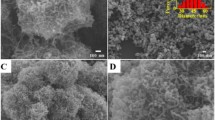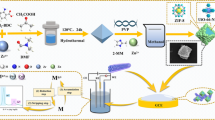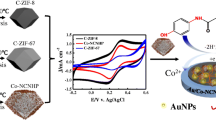Abstract
A core-shell ZIF-8@ZIF-67 was synthesized and pyrolyzed to get a Co nanoparticles-embedded N-doped carbon nanotube hollow polyhedron (Co@NCNHP). Then Au nanoparticles were formed on the surface and core of Co@NCNHP to obtain an Au-Co bimetal decorated NCNHP (Au-Co@NCNHP). The resultant nanocomposite was characterized by various methods including transmission electron microscopy, scanning electron microscopy, X-ray diffraction, X-ray photoelectron spectroscopy and Fourier transform infrared spectroscopy. The Au-Co@NCNHP-based electrochemical sensor displayed an obviously high electrocatalytic response to the oxidation of quercetin, which was attributed to the synergistic effects of Au-Co bimetal nanoparticles and N-doped carbon nanotube with hollow polyhedron. Under the optimal conditions, the oxidation peak currents exhibited a wide linear dynamic range for quercetin concentration from 0.050 to 35.00 μmol/L, and the detection limit was 0.023 ± 0.002 μmol/L (S/N = 3). The analytical applications of the proposed electrochemical sensor were checked by determining the content of quercetin in medical and onion samples with satisfactory results.

Grapical abstract






Similar content being viewed by others
References
Gomez FJV, Espino M, Fernandez MDLA, Raba J, Silva MF (2016) Enhanced electrochemical detection of quercetin by natural deep eutectic solvents. Anal Chim Acta 936:91–96
Ghoreishi SM, Masoum S, Mosleh M, Khoobi A (2018) Determination of quercetin in the presence of tannic acid in soft drinks based on carbon nanotubes modified electrode using chemometric approaches. Sensors Actuators B Chem 272:605–611
Xu B, Yang L, Zhao F, Zeng B (2017) A novel electrochemical quercetin sensor based on Pd/MoS2-ionic liquid functionalized ordered mesoporous carbon. Electrochim Acta 247:657–665
Jones DJL, Lim CK, Ferry DR, Gescher A (2015) Determination of quercetin in human plasma by HPLC with spectrophotometric or electrochemical detection. Biomed Chromatogr 12:232–235
Wu D, Chen Z (2014) ZnS quantum dots-based fluorescence spectroscopic technique for the detection of quercetin. Luminescence 29:307–313
Nielsen SE, Dragsted LO (1998) Column-switching high-performance liquid chromatographic assay for the determination of quercetin in human urine with ultraviolet absorbance detection. J Chromatogr B Biomed Sci Appl 707:81–89
Zhang W, Zong L, Geng G, Li Y, Zhang Y (2018) Enhancing determination of quercetin in honey samples through electrochemical sensors based on highly porous polypyrrole coupled with nanohybrid modified GCE. Sensors Actuators B Chem 257:1099–1109
Sun S, Zhang M, Li Y, He X(2013) A molecularly imprinted polymer with incorporated graphene oxide for electrochemical determination of quercetin. Sensors 13:5493–5506
Niu X, Li X, Chen W, Li X, Weng W, Yin C, Dong R, Sun W, Li G (2018) Three-dimensional reduced graphene oxide aerogel modified electrode for the sensitive quercetin sensing and its application. Mater Sci Eng C 89:230–236
Kyo Sung P, Zheng N, Cote AP, Jae Yong C, Rudan H, Uribe-Romo FJ, Chae HK, Michael OK, Yaghi OM (2006) Exceptional chemical and thermal stability of zeolitic imidazolate frameworks. Proc Natl Acad Sci U S A 103:10186–10191
Jing T, Salunkhe RR, Jian L, Torad NL, Masataka I, Shuhei F, Yusuke Y (2015) Thermal conversion of core-shell metal-organic frameworks: a new method for selectively functionalized nanoporous hybrid carbon. J Am Chem Soc 137:1572–1580
Yang J, Zhang F, Lu H, Hong X, Jiang H, Wu Y, Li Y(2015) Hollow Zn/Co ZIF particles derived from core-shell ZIF-67@ZIF-8 as selective catalyst for the semi-hydrogenation of acetylene. Angew Chem 127:11039–11043
Rosler C, Aijaz A, Turner S, Filippousi M, Shahabi A, Xia W, Van TG, Muhler M, Fischer RA (2016) Hollow Zn/Co zeolitic imidazolate framework (ZIF) and yolk-shell metal@Zn/Co ZIF nanostructures. Chemistry 22:3304–3311
Xin G, Li L, Zhang X, Chen J (2015) Platinum nanoparticles encapsulated in nitrogen-doped mesoporous carbons as methanol-tolerant oxygen reduction electrocatalysts. Chemelectrochem 2:404–411
Yang J, Zhao F, Zeng BZ (2016) Well-defined gold nanoparticle@N-doped porous carbon prepared from metal nanoparticle@metal-organic frameworks for electrochemical sensing of hydrazine. RSC Adv 6:23403–23410
Chen YZ, Cai GR, Wang YM, Qiang X, Yu SH, Jiang HL (2016) Palladium nanoparticles stabilized with N-doped porous carbons derived from metal-organic frameworks for selective catalysis in biofuel upgrade: the role of catalyst wettability. Green Chem 18:1212–1217
Yin P, Yao T, Wu Y, Zheng L, Lin Y, Liu W, Ju H, Zhu J, Hong X, Deng Z (2016) Single cobalt atoms with precise N-coordination as superior oxygen reduction reaction catalysts. Angew Chem 128:10958–10963
Chen YZ, Wang C, Wu ZY, Xiong Y, Xu Q, Yu SH, Jiang HL (2015) From bimetallic metal-organic framework to porous carbon: high surface area and multicomponent active dopants for excellent electrocatalysis. Adv Mater 27:5010–5016
Liu S, Wang Z, Zhou S, Yu F, Yu M, Chiang CY, Zhou W, Zhao J, Qiu J (2017) Metal-organic-framework-derived hybrid carbon nanocages as a bifunctional electrocatalyst for oxygen reduction and evolution. Adv Mater 29:1700874
Zhang J, Zhang T, Xiao K, Cheng S, Feng Y (2016) A novel and facile strategy for controllable synthesis of multi-layered core-shell zeolitic imidazolate frameworks. Cryst Growth Des 16:6494–6498
Pan Y, Sun K, Liu S, Cao X, Wu K, Cheong WC, Chen Z, Wang Y, Li Y, Liu Y (2018) Core-shell ZIF-8@ZIF-67 derived CoP nanoparticles-embedded N-doped carbon nanotube hollow polyhedron for efficient over-all water splitting. J Am Chem Soc 140:2610–2618
Huang SS, Liu L, Mei LP, Zhou JY, Guo FY, Wang AJ, Feng JJ (2015) Electrochemical sensor for nitrite using a glassy carbon electrode modified with gold-copper nanochain networks. Microchim Acta 183:791–797
Hsin YL, Hwang KC, Yeh C-T (2007) Poly (vinylpyrrolidone)-modified graphite carbon nanofibers as promising supports for PtRu catalysts in direct methanol fuel cells. J Am Chem Soc 129:9999–10010
Shi X, Zhang Z, Yun F, Gan Y (2015) Self-template synthesis of nitrogen-doped porous carbon derived from zeolitic imidazolate framework-8 as an anode for sodium ion batteries. Mater Lett 161:332–335
Cao F, Zhao M, Yu Y, Chen B, Huang Y, Yang J, Cao X, Lu Q, Zhang X, Zhang Z, Tan C, Zhang H (2016) Synthesis of two-dimensional CoS1.097/nitrogen-doped carbon nanocomposites using metal-organic framework nanosheets as precursors for supercapacitor application. J Am Chem Soc 138:6924–6927
Liu S, Wang J, Wang J, Zhang F, Liang F, Wang L (2014) Controlled construction of hierarchical Co1-xS structures as high performance anode materials for lithium ion batteries. CrystEngComm 16:814–819
Mao C, Kong A, Wang Y, Bu X, Feng P (2015) MIL-100 derived nitrogen-embodied carbon shells embedded with iron nanoparticles. Nanoscale 7:10817–10822
Maria A, Brett O, Ghica ME (2003) Electrochemical oxidation of quercetin. Electroanalysis 15:1745–1750
Ping X, Zhao F, Zeng B (2007) Voltammetric determination of quercetin at a multi-walled carbon nanotubes paste electrode. Microchem J 85:244–249
Kissinger P, Heineman WR (1996) Laboratory techniques in electroanalytical chemistry, 2nd edn. Marcel Dekker, New York
Laviron E (1979) General expression of the linear potential sweep voltammogram in the case of diffusionless electrochemical systems. J Electroanal Chem 101:19–28
Arvand M, Anvari M (2013) A graphene-based electrochemical sensor for sensitive detection of quercetin in foods. J Iran Chem Soc 10:841–849
Zhu W, Chen T, Ma X, Ma H, Chen S (2013) Highly sensitive and selective detection of dopamine based on hollow gold nanoparticles-graphene nanocomposite modified electrode. Colloids Surf B: Biointerfaces 111:321–326
Gholizadeh A, Shahrokhian S, Iraji zad A, Mohajerzadeh S, Vosoughi M, Darbari S, Koohsorkhi J, Mehran M (2012) Fabrication of sensitive glutamate biosensor based on vertically aligned CNT nanoelectrode array and investigating the effect of CNTs density on the electrode performance. Anal Chem 84:5932–5938
Yang C, Dong XX, Sun YM, Xu ZL, Li MY, Feng NN (2015) Nanoporous MgO based nonenzymatic electrochemical sensor for rapid screening of hydrogen peroxide in milk. RSC Adv 5:86485–86489
Slimestad R, Fossen T, Vagen IM (2007) Onions: a source of unique dietary flavonoids. J Agric Food Chem 55:10067–10080
Hertog MG, Hollman PC, Katan MB (1992) Content of potentially anticarcinogenic flavonoids of 28 vegetables and 9 fruits commonly consumed in the Netherlands. J Agric Food Chem 40:2379–2383
Zielinska D, Nagels L, Piskula M (2008) Determination of quercetin and its glucosides in onion by electrochemical methods. Anal Chim Acta 617:22–31
Nile SH, Nile AS, Keum YS, Sharmab K (2017) Utilization of quercetin and quercetin glycosides from onion (Allium cepa L.) solid waste as an antioxidant, urease and xanthine oxidase inhibitors. Food Chem 235:119–126
Funding
This project was financially supported by the National Natural Science Foundation of China (21665007, 21964007), the National College Students Innovation and Entrepreneurship Training Program (30101100307), Graduate Student Innovation Research Projects of Hainan Normal University (Hsyx2018-9), Hainan Provincial Natural Science Foundation of High Level-talent Project (2019RC188), and Open Project of Chemistry Department of Qingdao University of Science and Technology (QUSTHX201935).
Author information
Authors and Affiliations
Corresponding author
Ethics declarations
Conflict of interest
The authors declare that they have no conflict of interest.
Ethical approval
All the experiments were performed in compliance with the ethical standards of the relevant laws and institutional guideline of P. R. China, and with the 1964 Helsinki declaration. The studies were approved by the Ethics Committee of the College of Chemistry and Chemical Engineering, Hainan Normal University, P. R. China.
Additional information
Publisher’s note
Springer Nature remains neutral with regard to jurisdictional claims in published maps and institutional affiliations.
Electronic supplementary material
ESM 1
Supplementary data associated with this article can be found in the online version (DOCX 2990 kb).
Rights and permissions
About this article
Cite this article
Luo, G., Deng, Y., Zhu, L. et al. Au-Co nanoparticles-embedded N-doped carbon nanotube hollow polyhedron modified electrode for electrochemical determination of quercetin. Microchim Acta 187, 546 (2020). https://doi.org/10.1007/s00604-020-04531-0
Received:
Accepted:
Published:
DOI: https://doi.org/10.1007/s00604-020-04531-0




